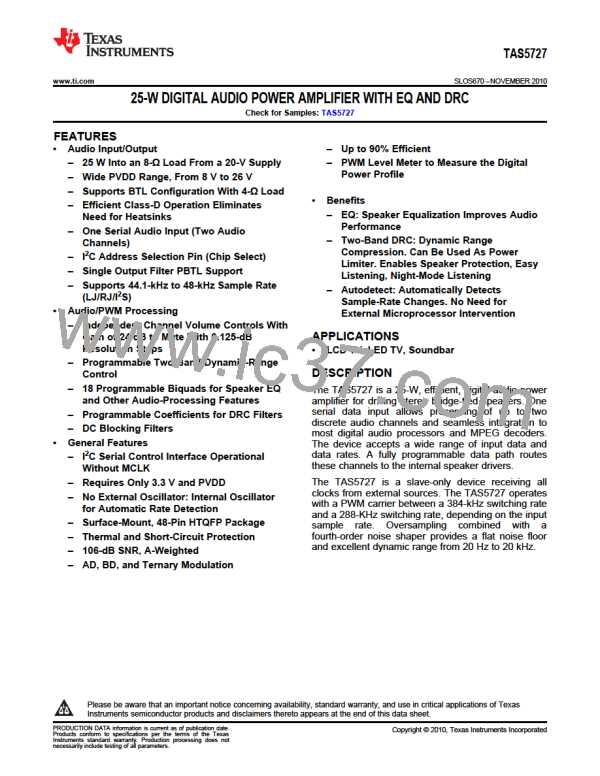TAS5727
SLOS670 –NOVEMBER 2010
www.ti.com
Table 1. A_SEL_FAULT Output States
A_SEL_FAULT
DESCRIPTION
0
Overcurrent (OC) or undervoltage (UVP) error or overtemperature error (OTE) or overvoltage
error
1
No faults (normal operation)
SSTIMER FUNCTIONALITY
The SSTIMER pin uses a capacitor connected between this pin and ground to control the output duty cycle when
exiting all-channel shutdown. The capacitor on the SSTIMER pin is slowly charged through an internal current
source, and the charge time determines the rate at which the output transitions from a near-zero duty cycle to the
desired duty cycle. This allows for a smooth transition that minimizes audible pops and clicks. When the part is
shut down, the drivers are placed in the high-impedance state and transition slowly down through a 3-kΩ resistor,
similarly minimizing pops and clicks. The shutdown transition time is independent of the SSTIMER pin
capacitance. Larger capacitors increase the start-up time, while capacitors smaller than 2.2 nF decrease the
start-up time. The SSTIMER pin should be left floating for BD modulation.
CLOCK, AUTODETECTION, AND PLL
The TAS5727 is an I2S slave device. It accepts MCLK, SCLK, and LRCLK. The digital audio processor (DAP)
supports all the sample rates and MCLK rates that are defined in the clock control register .
The TAS5727 checks to verify that SCLK is a specific value of 32 fS, 48 fS, or 64 fS. The DAP only supports a 1 ×
fS LRCLK. The timing relationship of these clocks to SDIN is shown in subsequent sections. The clock section
uses MCLK or the internal oscillator clock (when MCLK is unstable, out of range, or absent) to produce the
internal clock (DCLK) running at 512 times the PWM switching frequency.
The DAP can autodetect and set the internal clock control logic to the appropriate settings for all supported clock
rates as defined in the clock-control register.
The TAS5727 has robust clock error handling that uses the built-in trimmed oscillator clock to quickly detect
changes/errors. Once the system detects a clock change/error, it mutes the audio (through a single-step mute)
and then forces PLL to limp using the internal oscillator as a reference clock. Once the clocks are stable, the
system autodetects the new rate and reverts to normal operation. During this process, the default volume is
restored in a single step (also called hard unmute). The ramp process can be programmed to ramp back slowly
(also called soft unmute) as defined in volume register (0x0E).
SERIAL DATA INTERFACE
Serial data is input on SDIN. The PWM outputs are derived from SDIN. The TAS5727 DAP accepts serial data in
16-, 20-, or 24-bit left-justified, right-justified, and I2S serial data formats.
PWM SECTION
The TAS5727 DAP device uses noise-shaping and customized nonlinear correction algorithms to achieve high
power efficiency and high-performance digital audio reproduction. The DAP uses a fourth-order noise shaper to
increase dynamic range and SNR in the audio band. The PWM section accepts 24-bit PCM data from the DAP
and outputs two BTL PWM audio output channels.
The PWM section has individual-channel dc-blocking filters that can be enabled and disabled. The filter cutoff
frequency is less than 1 Hz. Individual-channel de-emphasis filters for 44.1 kHz and 48 kHz are included and can
be enabled and disabled.
Finally, the PWM section has an adjustable maximum modulation limit of 93.8% to 99.2%.
For a detailed description of using audio processing features like DRC and EQ, see the User's Guide and
TAS570X GDE software development tool documentation.
18
Submit Documentation Feedback
Copyright © 2010, Texas Instruments Incorporated
Product Folder Link(s): TAS5727

 TI [ TEXAS INSTRUMENTS ]
TI [ TEXAS INSTRUMENTS ]